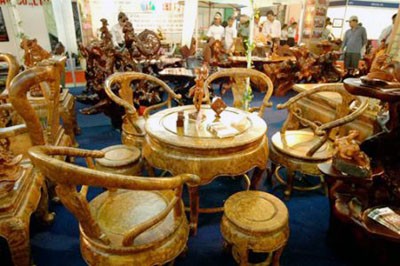Tapping advantages for global reach
The Vietnam General Department of Customs (GDC) recent figures show that during 2014-2016, Vietnam’s export value of wood and wooden products rose robustly. Specifically, the country posted nearly $7 billion from wood and wooden products export in 2016, up 1.1 per cent on-year and ranking seventh in terms of export value among Vietnam’s top export earners. Of this, the export value from wooden furniture hit $5.12 billion, a 7.1 per cent jump against 2015, representing 73.6 per cent of the sector’s total export value of wood and wooden products.
The wood processing industry is also proud of having dynamical and creative businesses. At present, the country is home to more than 4,200 businesses, of them private firms account for 95 per cent (including 16 per cent of foreign invested businesses), and state-owned enterprises (SOEs) 5 per cent. Well-established brands in wood processing are mainly private firms, such as Duc Long Gia Lai Wood Processing, Truong Thanh Furniture, and Duc Thanh Wood Processing, to name but a few. These firms have invested in leading-edge wood processing lines to meet ever-stringent domestic and export market demands.

Craft villages’ development is also noteworthy to mention. Vietnam is home to more than 340 traditional craft villages with tens of thousands of households engaged in wooden items processing. There, most of the production stage is hand-made, but some phases have been mechanized. The artisans’ dexterity has breathed ‘soul’ into the products, turning many of them into true master pieces of art. Vietnamese wooden furniture have been praised for good quality, high aesthetic standards, reasonable pricing and diversified types.
In late 2016, after nearly six years sitting on negotiations including 10 high-level sessions and 18 technical matter sessions, on November 18, 2016 Vietnam basically finished negotiating the Voluntary Partnership Agreement (VPA) on Forest Law Enforcement Governance and Trade (FLEGT) between Vietnam and EU. Vietnam has also formulated the internationally recognized Vietnam Timber Legality Assurance System (VNTLAS) which not only matched free trade agreement (FTA) regulations, but also contributed to enhancing the competitiveness of Vietnamese wooden products in the international market. These legal documents have played a role in bettering local relevant regulatory system on forest and export wood processing management to reach international practices and attracting funding and international support for capacity-building of local businesses, households and VNTLASS enforcement agencies.

South Korea: New market
South Korea emerges as one of Vietnam’s key export markets in respect to wood and wooden products. The two countries share many similarities in the way of eating and dressing. Korean consumers today tend to use simple items for their houses. They, therefore, like choosing small dimension wooden furniture which incorporate many functions but are competitively priced. They are also fond of using decorative wooden products which are the advantage of Vietnamese wood processing firms. This was one of the main causes why South Korea had moved to the fourth position among Vietnam’s top five export markets of wood and wooden products in 2016.
Already meeting strict quality standards set by picky markets like EU and the US, and as Vietnam has formulated VNTLAS, it is not difficult for made-in-Vietnam wood and wooden products to satisfy Korean quality requirements. Thereby, following enforcement of Vietnam-Korea FTA (VKFTA) the mutual trade value of wood products between Vietnam and Korea is expected to increase rapidly in the upcoming years through leveraging multi-faceted cooperation in political, diplomatic, cultural, investment and trade fields between the two countries particularly, and international market integration trend generally.

